The American Trends Panel survey methodology
Overview
The American Trends Panel (ATP), created by Pew Research Center, is a nationally representative panel of randomly selected U.S. adults. Panelists participate via self-administered web surveys. Panelists who do not have internet access at home are provided with a tablet and wireless internet connection. Interviews are conducted in both English and Spanish. The panel is being managed by Ipsos.
Data in this report is drawn from the panel wave conducted from Aug. 1 to Aug. 14 and included oversamples of Hispanic, Asian and Black adults, as well as 18-29 year old Republicans and Republican leaning independents in order to provide more precise estimates of the opinions and experiences of these smaller demographic subgroups. These oversampled groups are weighted back to reflect their correct proportions in the population. A total of 7,647 panelists responded out of 13,221 who were sampled, for a response rate of 65%. This included 6,025 respondents from the ATP and an oversample of 1,622 Hispanic respondents from Ipsos’ KnowledgePanel. The cumulative response rate accounting for nonresponse to the recruitment surveys and attrition is 3%. The break-off rate among panelists who logged on to the survey and completed at least one item is 2%. The margin of sampling error for the full sample of 7,647 respondents is plus or minus 1.7 percentage points.
Panel recruitment
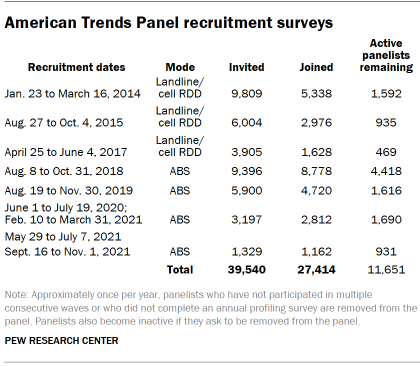
The ATP was created in 2014, with the first cohort of panelists invited to join the panel at the end of a large, national, landline and cellphone random-digit-dial survey that was conducted in both English and Spanish. Two additional recruitments were conducted using the same method in 2015 and 2017, respectively. Across these three surveys, a total of 19,718 adults were invited to join the ATP, of whom 9,942 (50%) agreed to participate.
In August 2018, the ATP switched from telephone to address-based recruitment. Invitations were sent to a stratified, random sample of households selected from the U.S. Postal Service’s Delivery Sequence File. Sampled households receive mailings asking a randomly selected adult to complete a survey online. A question at the end of the survey asks if the respondent is willing to join the ATP. Starting in 2020 another stage was added to the recruitment. Households that do not respond to the online survey are sent a paper version of the questionnaire, $5 and a postage-paid return envelope. A subset of the adults returning the paper version of the survey are invited to join the ATP. This subset of adults receive a follow-up mailing with a $10 pre-incentive and invitation to join the ATP.
Across the four address-based recruitments, a total of 19,822 adults were invited to join the ATP, of whom 17,472 agreed to join the panel and completed an initial profile survey. In each household, the adult with the next birthday was asked to go online to complete a survey, at the end of which they were invited to join the panel. Of the 27,414 individuals who have ever joined the ATP, 11,651 remained active panelists and continued to receive survey invitations at the time this survey was conducted.
The U.S. Postal Service’s Delivery Sequence File has been estimated to cover as much as 98% of the population, although some studies suggest that the coverage could be in the low 90% range.1 The American Trends Panel never uses breakout routers or chains that direct respondents to additional surveys.
Sample design
The overall target population for this survey was non-institutionalized persons ages 18 and older living in the U.S., including Alaska and Hawaii. It featured a stratified random sample from the ATP in which Hispanic, Asian and Black adults, as well as 18-29 year old Republicans and Republican leaning independents were selected with certainty were selected with certainty. The remaining panelists were sampled at rates designed to ensure that the share of respondents in each stratum is proportional to its share of the U.S. adult population to the greatest extent possible. Respondent weights are adjusted to account for differential probabilities of selection as described in the Weighting section below.
The ATP was supplemented with an oversample of self-identified Hispanic respondents from the KnowledgePanel who were of Mexican origin, Central American ancestry or who had no more than a high-school education.
Questionnaire development and testing
The questionnaire was developed by Pew Research Center in consultation with Ipsos. The web program was rigorously tested on both PC and mobile devices by the Ipsos project management team and Pew Research Center researchers. The Ipsos project management team also populated test data that was analyzed in SPSS to ensure the logic and randomizations were working as intended before launching the survey.
Incentives
All respondents were offered a post-paid incentive for their participation. Respondents could choose to receive the post-paid incentive in the form of a check or a gift code to Amazon.com or could choose to decline the incentive. Incentive amounts ranged from $5 to $20 depending on whether the respondent belongs to a part of the population that is harder or easier to reach. Differential incentive amounts were designed to increase panel survey participation among groups that traditionally have low survey response propensities.
Ipsos operates an ongoing modest incentive program for KnowledgePanel to encourage participation and create member loyalty. The incentive program includes special raffles and sweepstakes with both cash rewards and other prizes to be won. Typically, panel members are assigned no more than one survey per week. On average, panel members complete two to three surveys per month with durations of 10 to 15 minutes per survey. An additional incentive is usually provided for longer surveys. For this survey, during the last few days of data collection, KnowledgePanel members were offered 10,000 points (equivalent to $10) in addition to the regular incentive program in an attempt to boost the number of responses from panel members of Central American ancestry.
Data collection protocol
The data collection field period for this survey was Aug. 1 to Aug. 14, 2022. Postcard notifications were mailed to all ATP panelists with a known residential address on Aug. 1, 2022.
Invitations were sent out in two separate launches: Soft Launch and Full Launch. Sixty ATP panelists and 909 KP panelists were included in the soft launch, which began with an initial invitation sent on Aug. 1, 2022. The ATP panelists chosen for the initial soft launch were known responders who had completed previous ATP surveys within one day of receiving their invitation.
All remaining English- and Spanish-speaking panelists were included in the full launch and were sent an invitation on Aug. 3, 2022.
All panelists with an email address received an email invitation and up to four email reminders if they did not respond to the survey. All ATP panelists that consented to SMS messages received an SMS invitation and up to four SMS reminders.
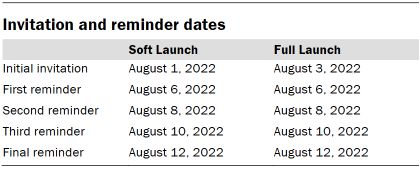
Data quality checks
To ensure high-quality data, the Center’s researchers performed data quality checks to identify any respondents showing clear patterns of satisficing. This includes checking for very high rates of leaving questions blank, as well as always selecting the first or last answer presented. As a result of this checking, 12 ATP and seven KP respondents were removed from the survey dataset prior to weighting and analysis.
Weighting
The data was weighted in a multistep process that accounts for multiple stages of sampling and nonresponse that occur at different points in the survey process. First, each panelist began with a base weight that reflects their probability of selection for their initial recruitment survey. These weights were then adjusted to account for each panelist’s probability of being sampled to participate in this wave.
Next, respondents were placed into one of five sample groups: 1) Hispanic adults of Mexican origin 2) Hispanic adults of Central American origin 3) Other Hispanic adults with no more than a high school education 4) Other Hispanic adults with more than a high school education 5) Non-Hispanic adults. Separately within each group, the weights for ATP and KnowledgePanel respondents were scaled to be proportional to their effective sample size within that group. The ATP and KnowledgePanel respondents were then recombined and the weights were poststratified so that the weighted proportion of adults in each of the five groups matched its estimated share of the of the U.S. adult population.
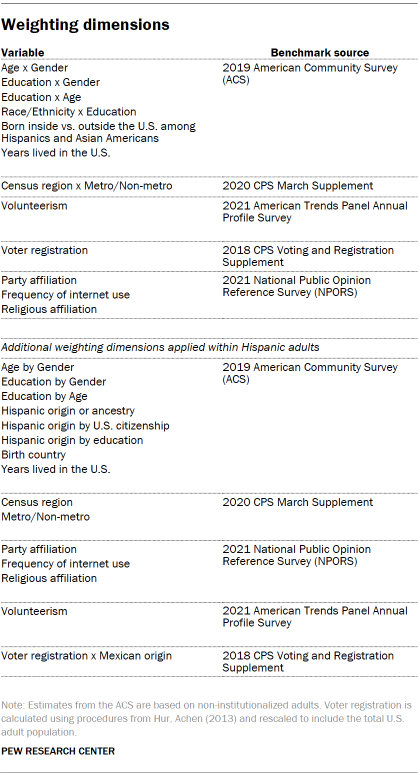
The weights were then calibrated to align with the population benchmarks identified in the accompanying table. These include a set of weighting parameters for the total U.S. adult population as well as an additional set of parameters specifically for Hispanic adults. Separately for each sample group, the weights were then trimmed at the 1st and 99th percentiles to reduce the loss in precision stemming from variance in the weights. Sampling errors and tests of statistical significance take into account the effect of weighting.
Some of the population benchmarks used for weighting come from surveys conducted prior to the coronavirus outbreak that began in February 2020. However, the weighting variables for most ATP members were measured in 2022. A small number of panelists for which 2022 measures were not available use profile variables measured in 2021.For KnowledgePanel respondents, many of the weighting variables were measured on this wave.
This does not pose a problem for most of the variables used in the weighting, which are quite stable at both the population and individual levels. However, volunteerism may have changed over the intervening period in ways that made these more recent measurements incompatible with the available (pre-pandemic) benchmarks. To address this, volunteerism is weighted to an estimated benchmark that attempts to account for possible changes in behavior.
The weighting parameter is estimated using the volunteerism profile variable that was measured on the full American Trends Panel in 2021 but weighted using the profile variable that was measured in 2020. For all other weighting dimensions, the more recent panelist measurements were used. For American Trends panelists recruited in 2021, the 2020 volunteerism measure was imputed using data from existing panelists with similar characteristics.
This ensures that any patterns of change that were observed in the existing panelists were also reflected in the new recruits when the weighting was performed.
The following table shows the unweighted sample sizes and the error attributable to sampling that would be expected at the 95% level of confidence for different groups in the survey.
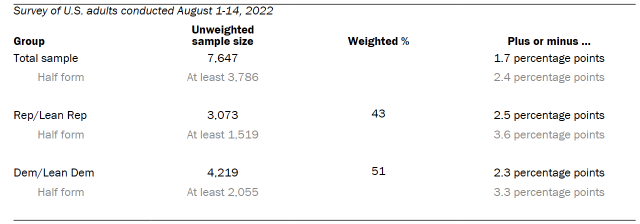
Sample sizes and sampling errors for other subgroups are available upon request. In addition to sampling error, one should bear in mind that question wording and practical difficulties in conducting surveys can introduce error or bias into the findings of opinion polls.
Additional wave methodology
This report also features a question fielded in an earlier survey. Further information for that question can be found here.
Dispositions and response rates
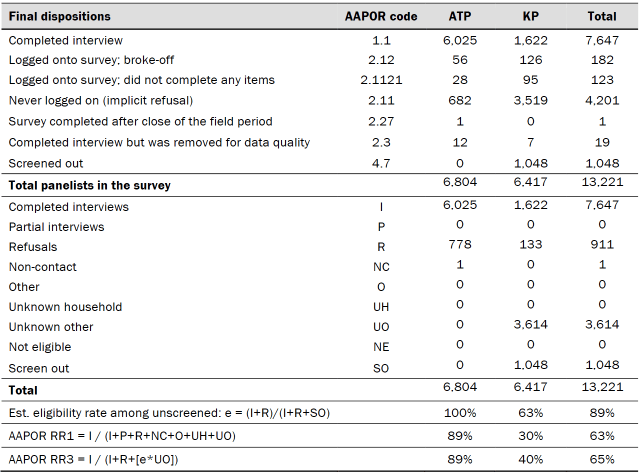

Adjusting income and defining income tiers
Family income data reported in this study is adjusted for household size and cost-of-living differences by geography using a similar methodology to Pew Research Center’s previous work on the American middle class. The income tiers used in this analysis are also created following methodology previously used in the Center’s work on the middle class.
Prior to these adjustments, American Trends Panel members were assigned to the midpoint of the income range they selected during the survey to provide an exact income figure for adjustment.
The metropolitan area cost-of-living adjustment is based on price indexes published by the U.S. Bureau of Economic Analysis. These indexes, known as Regional Price Parities (RPP), compare the prices of goods and services across 384 metropolitan statistical areas as well as non-metro areas with the national average prices for the same goods and services. The most recent available data is from 2020.
The national estimates presented in the analysis encompass the U.S. adult population. Those who fall outside of the 381 metropolitan statistical areas in which current ATP panelists reside are assigned the RPP for their state’s non-metropolitan area.
Family incomes are then adjusted for the number of people in a household using the methodology from Pew Research Center’s previous work on the American middle class. That is done because a four-person household with an income of say, $50,000, faces a tighter budget constraint than a two-person household with the same income.
“Middle-income” adults are in families with annual incomes that are two-thirds to double the median family income in the full ATP sample after incomes have been adjusted for household size and the local cost of living. The median family income for the panel is roughly $65,800 for an average family of three. Using this median income, the middle-income range is about $43,800 to $131,500 annually for a three-person family. Lower-income families have incomes less than roughly $43,800 and upper-income families have incomes greater than roughly $131,500 (all figures expressed in 2021 dollars).
Of the 6,025 ATP panelists that completed the Wave 113 survey, there were 326 who had not yet completed the ATP’s 2022 annual profile survey that collects updated demographic data on all ATP panelists. Because updated measures of family income and place of residence were not available for these respondents, they are assigned their income tier from the previous year(based on their 2020 family income, 2020 place of residence and 2019 regional price parity). Based on these adjustments, 31% of respondents in Wave 113 are lower income, 47% are middle income and 16% fall into the upper-income tier. An additional 6% either didn’t offer a response to the income question or the household size question.
Two examples of how a given area’s cost-of-living adjustment was calculated are as follows: the Florence-Muscle Shoals metropolitan area in Alabama is a relatively inexpensive area, with a price level that is 17.6% less than the national average. The San Francisco-Oakland-Berkeley metropolitan area in California is one of the most expensive areas, with a price level that is 17.4% higher than the national average. Income in the sample is adjusted to make up for this difference. As a result, a family with an income of $41,200 in the Florence area is equivalent to a family with an income of $58,700 in San Francisco.
© Pew Research Center, 2022


